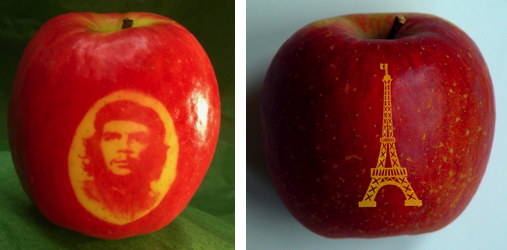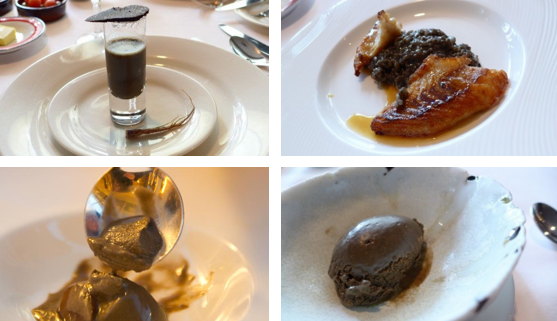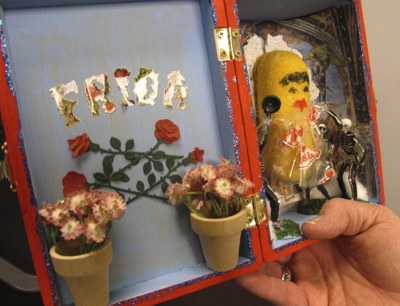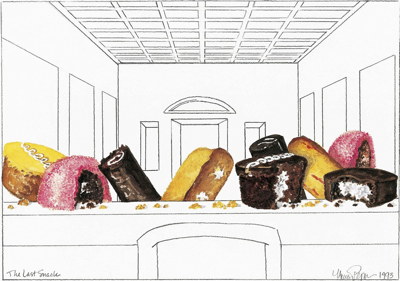Food
Kangaroo Meat Scandal, 1960
The horse meat scandal is widening in Europe, with reports now surfacing that Ikea's meatballs have been found to contain horse. Ikea insists the meatballs sold in the U.S. are horse-less, even though the U.S. and European meatballs come from the same supplier.Of course, the U.S. has its own history of meat scandals, such as back in 1960 when Pennsylvanians got "hopping mad" to discover kangaroo meat was being mixed into their sausages and bologna.
In the past, I've purposefully had horse sausage and kangaroo filet. Or, at least, that's what I was told I was being served. Who knows. Maybe they were both really pork. I would never have been able to tell the difference.
Posted By: Alex - Mon Feb 25, 2013 -
Comments (6)
Category: Food
Tattooed Apples
Ediblegeography.com delves into the history of apple tattooing. The concept is simple. You place a stencil on the fruit so that part of the skin isn't exposed to the sun, leaving a permanent image when the stencil is removed. However, getting it right is time consuming, so it's not a practice commercial farmers are likely to adopt. Pity, since I'd much prefer an apple tattoo over those obnoxious stickers that all the supermarket apples have on them. See more images of tattooed apples at the Société Régionale d’Horticulture de Montreuil.
Posted By: Alex - Tue Feb 19, 2013 -
Comments (6)
Category: Food
Who Dat Say Chicken in Dis Crowd?
I learned of this song during a musical celebration of Black History Month on radio station WQXR. Certainly an artifact of its time.
You can mentally combine the instrumental music in the player with the words below.
Who Dat Say Chicken In Dis Crowd
There was once a great assemblage of the cullud population,
all the cullud swells was there,
They had got them-selves together to discuss the situation
and rumours in the air.
There were speakers there from Georgia and some from Tennessee,
who were making feather fly,
When a roostah in the bahn-ya'd flew up what folks could see,
Then those darkies all did cry.
Chorus:
Who dat say chicken in dis crowd?
Speak de word agin' and speak it loud--
Blame de lan' let white folks rule it,
I'se a lookin fu a pullet,
Who dat say chicken is dis crowd.
A famous culled preacher told his listnin' congregation,
all about de way to ac',
Ef dey want to be respected and become a mighty nation
to be hones' Fu' a fac'.
Dey mus nebber lie, no nebber, an' mus' not be caught a-stealin'
any pullets fun de lin',
But an aged deacon got up an' his voice it shook wif feelin',
As dese words he said to him.
Chorus:
Who dat say chicken in dis crowd?
Speak de word agin' and speak it loud--
What's de use of all dis talkin',
Let me hyeah a hen a sqauwkin'
Who dat say chicken in dis crowd.
Posted By: Paul - Mon Feb 18, 2013 -
Comments (1)
Category: Food, Music, Stereotypes and Cliches, Nineteenth Century
Electric Waffles for Valentine’s Day
Posted By: Alex - Thu Feb 14, 2013 -
Comments (5)
Category: Food, Holidays, 1920s
Fried Dandelions
It would never have occurred to me to go out into the yard and fry up some dandelions.
dailyspud.com
• Rinse your dandelion flowers and gently pat dry using some kitchen paper.
• Place a frying pan over a medium heat and, when hot, add a thin layer of oil to the pan.
• Mix the polenta with the salt, black pepper, dried thyme and dried oregano.
• Dip the flowers first in the beaten egg and then in the seasoned polenta.
• Fry in batches, stalk side up, for around 3 minutes or until golden. Remove and drain on kitchen paper.
• Eat as a snack or use to surprise, and maybe even delight, unsuspecting family and friends.
Posted By: Alex - Tue Feb 12, 2013 -
Comments (12)
Category: Food
Dirt Food
Chef Toshio Tanabe envisions his Tokyo restaurant Ne Quittez Pas as being like "a nature-surrounded auberge in southern France" where people can sit and eat dirt. His dirt-themed dishes include potato starch and dirt soup, salad with dirt dressing, sea bass with dirt risotto, dirt gratin, dirt ice cream, and dirt mint tea. However, this isn't just any dirt. It's "lab-tested…first-class agricultural soil from the farmlands north of Tokyo, baked, boiled, triple-filtered and mixed with gelatine." [foxnews]
Posted By: Alex - Fri Feb 08, 2013 -
Comments (4)
Category: Food
Happy Superbowl Watching… Please Pass the Feces!
The Physicians Committee for Responsible Medicine has a message for all the people going to Superbowl parties today:They go into more detail:

Posted By: Alex - Sun Feb 03, 2013 -
Comments (7)
Category: Food, Excrement
Last-Meal Plates
Artist Julie Green creates plates that show the last meals of death-row inmates. She's been creating these plates for 13 years and now has around 500 of them. The most popular last-meal request? Junk food from KFC and McDonald's. [Daily Mail]
Posted By: Alex - Wed Jan 30, 2013 -
Comments (3)
Category: Art, Food, Junk Food, Prisons
Twinkies Art
Artist Nancy Peppin specializes in using Twinkies in her work. She sees herself as working in the tradition of Warhol. His Campbell's soup can art was her initial inspiration. Sometimes she makes art out of the sponge cakes themselves, and sometimes she creates paintings, photographic prints, etc. that feature Twinkies. Either way, they're her muse.She's been creating Twinkies art since 1975, but thanks to the current woes of Hostess, she's been getting lots of attention recently. What I'm curious about is how she preserves the Twinkies to make sure they don't rot. Because that idea of Twinkies never rotting is just an urban legend. I also couldn't find any info on how much her pieces go for. [huffpost]


Posted By: Alex - Mon Jan 28, 2013 -
Comments (4)
Category: Art, Food, Junk Food
The Pasta Art of Vernon Spicer
Vernon Spicer was in his 60s when he began his career as an artist. One night he was woken by a dream, "I could see something that had a three-dimensional design, one that involved me using sticks to create.” His wife suggested the sticks were pieces of uncooked spaghetti. So he started using uncooked pasta to make paintings. As the Montgomery Advertiser puts it, "this man really knows how to use his noodle to utilize noodles."If you decide to buy one of his paintings — I think the three below are his entire oeuvre — the price is $1800. He hasn't sold any yet, so you have a chance to be the first!
The pictures are from the Selma Alabama Photo Blog, which has higher-res versions posted. Though I suspect the pasta paintings, in real life, have a 3-D effect that the photos can't convey.



Posted By: Alex - Sat Jan 05, 2013 -
Comments (3)
Category: Art, Food

| Who We Are |
|---|
| Alex Boese Alex is the creator and curator of the Museum of Hoaxes. He's also the author of various weird, non-fiction, science-themed books such as Elephants on Acid and Psychedelic Apes. Paul Di Filippo Paul has been paid to put weird ideas into fictional form for over thirty years, in his career as a noted science fiction writer. He has recently begun blogging on many curious topics with three fellow writers at The Inferior 4+1. Contact Us |






